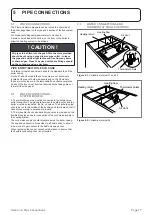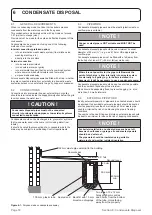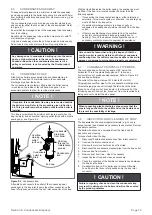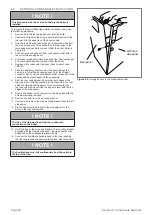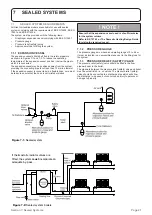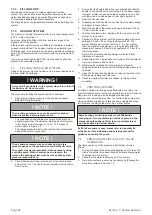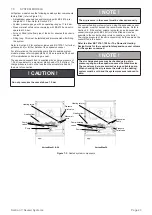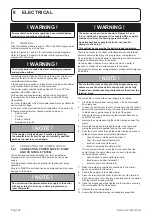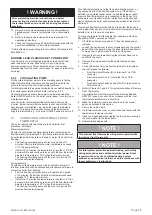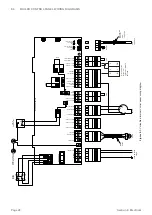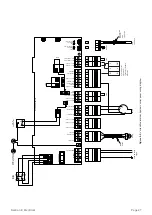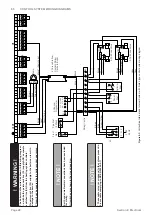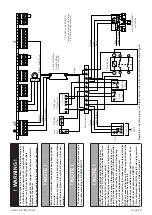
Section 4: Installation
Page 14
4.1 INTRODUCTION
The boiler is supplied already fully assembled in a carton which
is carefully packed with packing materials. The installation
procedure therefore begins with unpacking of the packed boiler.
4.2
BOILER LOCATION
The boiler must stand on a firm and level surface capable of
supporting the boiler when full of water. Refer to Section 2.1 for
weights.
It does not require a special hearth as the temperature of the
boiler base is less than 50°C.
Sufficient clearance must be allowed at the front of the boiler to
remove the burner and baffles for servicing.
Internal models
Once the boiler has been installed, a permanent worktop may be
fitted over it as access to the top of the boiler is no longer required
after installation.
Internal system models
! NOTE !
A removable section of worktop above the boiler is
required to provide access for servicing.
Care should be taken when siting the condensate trap if it is to be
fitted outside the boiler. Refer to Section 6.
4.3
REGULATIONS COMPLIANCE
! NOTE !
Failure to install and commission appliances correctly may
invalidate the boiler guarantee.
Installation of a Grant Vortex boiler must be in accordance with
the following recommendations:
•
Building Regulations for England and Wales, and the Building
Standards for Scotland issued by the Department of the
Environment and any local Byelaws which you must check
with the local authority for the area.
•
Model and local Water Undertaking Byelaws.
•
Applicable Control of Pollution Regulations.
•
National Building Regulations and any local Byelaws.
•
Model Byelaws and the Water Supply Regulations.
•
The following OFTEC requirements:
•
OFS T100 Polythene oil storage tanks for distillate fuels.
•
OFS T200 Fuel oil storage tanks and tank bunds for use
with distillate fuels, lubrication oils and waste oils.
Further information may be obtained from the
OFTEC Technical Book 3 (Installation requirements
for oil storage tanks) and OFTEC Technical Book 4
(Installation requirements for oil fired boilers).
The installation should also be in accordance with the latest
edition of the following British Standard Codes of Practice (and
any relevant amendments):
•
BS 5410-1: 2019 (Code of practice for liquid fuel firing.
Installations for space heating and hot water supply purposes
for domestic buildings)
•
This standard covers domestic installations up to 70kW.
•
BS 5410-2: 2018 (Code of practice for liquid fuel firing. Non-
domestic installations)
•
This standard should be followed with regard to
installations with an output capacity in excess of 70kW.
•
Where the combined outputs of multiple appliances
located together at a domestic dwelling exceed 70kW
then then a dedicated plant room as specified in BS
5410-2 is recommended.
•
BS EN 12828 (Heating systems in buildings. Design for
water-based heating systems)
•
BS EN 12831-1 (Energy performance of buildings. Method
for calculation of the design heat load)
•
BS EN 14336 (Heating systems in buildings. Installation and
commissioning of water based heating systems)
•
BS 7593 (Code of Practice for treatment of water in domestic
hot water central heating systems)
•
BS 7671 (Requirements for Electrical installations, IET Wiring
Regulations)
•
BS 7291 (Thermoplastics pipe and fitting systems for hot and
cold water for domestic purposes and heating installations in
buildings. General requirements)
•
BS 7074-1 (Application, selection and installation of
expansion vessels and ancillary equipment for sealed water
systems. Code of practice for domestic heating and hot water
supply)
•
BS 2869 (Fuel oils for agricultural, domestic and industrial
engines and boilers. Specification)
! WARNING !
BS5410-1: 2019 requires that appliances located in a
building or structure or within a restricted area externally
should have a CO detector conforming to BS EN 50291-1
installed in the same room/space.
4.4
HEATING SYSTEM DESIGN
CONSIDERATIONS
! WARNING !
Before starting any work on the boiler or fuel supply,
please read the Health and Safety information given in
Section 15.
To achieve the maximum efficiency possible from the Grant Vortex
boiler, the heating system should be designed to the following
parameters:
RADIATORS:
•
Flow temperature 70°C
•
Return temperature 50°C
•
Differential 20°C
Size radiators with a mean water temperature of 60°C.
Design system controls with programmable room thermostats
or use weather compensating controls to maintain return
temperatures below 55°C.
! NOTE !
The boiler should not be allowed to operate with return
temperatures of less than 40°C when the system is up to
temperature.
The use of a pipe thermostat is recommended to control the re-
turn temperature when using weather compensating controls.
UNDERFLOOR:
•
Flow temperature 50°C
•
Return temperature 40°C
•
Differential 10°C
In underfloor systems, it is essential that the return temperature
must be maintained at or above 40°C to prevent internal corrosion
of the boiler water jacket.
Refer to Section 2.5 for the size and type of the connections and
Section 5 for the position of the connections.
4 INSTALLATION

















